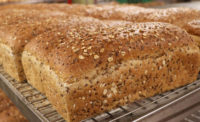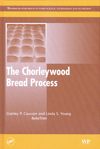State of the Industry 2020: Bread, bagels, and English muffins gain ground
Cornerstone bakery products like fresh bread, bagels, and English muffins are gaining ground










The past year has provided several key indicators that fresh bread products—including packaged bread, bagels, and English muffins—are gaining new levels of consumer interest. Sales are up, and the ongoing COVID-19 pandemic has reinforced consumer attachments to core these time-honored pantry staples.
Market data
At this time last year, our 2019 State of the Industry analysis for breads noted category losses for fresh bread and English muffins, with only a 4.7 percent gain for the bagels/bialys category. This year’s analysis has decidedly more-positive note. The 52 weeks ending April 19, 2020 saw gains across every category in fresh bread. And bread sales saw a significant uptick to date in 2020 due to pantry stocking related to the COVID-19 pandemic.
Overview | Bread | Tortillas | Sweet Goods | Snack Cakes | Pizza | Desserts | Cookies | Buns & Rolls | Bars | Breakfast Products
Per IRI, Chicago, the fresh bread segment of fresh bread and rolls grew 3.5 percent to $9.4 billion. While private label lost some ground, down 0.6 percent to $1.8 billion, the top two companies in fresh bread both posted gains, with Grupo Bimbo up 1.4 percent to $2.5 billion, and Flowers Foods up 9.0 percent to $2.3 billion. H&S Bakery had another strong year, up 14.4 percent to $119.0 million.
The bagels category saw growth of 7.8 percent for the year, with sales of $1.0 billion. Grupo Bimbo grew 5.2 percent for the year, increasing revenue to $639.5 million. That number should continue to grow in the wake of acquiring Lender’s from Conagra Brands at the start of 2020. Flowers Foods, including its organic Dave’s Killer Bread brand, had another great year for bagel sales, up 28.5 percent to $87.6 million. Toufayan Bakery also saw strong growth for its hearth-baked bagels for the year, up 17.9 percent to $9.2 million.
English muffins rebounded as a category for the year, up 2.0 percent to $717.4 million. Flowers Foods was the star of the category, up 110.9 percent to $19.2 million—again, partially thanks to growth of its Dave’s Killer Bread brand. United States Bakery/Franz tracked well for the year, up 13.7 percent to $16.8 million. And Food for Life Baking Co. also had a good year for its better-for-you English muffins, up 12.2 percent to $15.9 million.
Looking back
Paul Baker, co-founder, St Pierre Groupe, Manchester, England—the 2019 SF&WB “Bakery of the Year”—highlights the following trends as instrumental to the bread category over the past year:
- Smaller-format breads. Demi-baguettes, as well as half or small loaf products, accommodate smaller household sizes.
- Better-for-you. Consumers continue to seek wholesome options, including the use of whole, ancient, and sprouted grains, and thinner/smaller portion sizes. Longer-fermented and higher-fiber breads support gut health and are of interest to consumers to support an active, healthy lifestyle. In addition, with new labeling mandates, added sugar is of concern.
- Artisan. Old World, authentic breads leveraging responsibly sourced grains and long fermentation times continue to grow. Artisan bakeries are working directly with farmers to cultivate and use quality grains that are often milled fresh and are a point of pride for bakers.
- Globally inspired. Every country and culture has its own version of bread. The growing love for global flavors and authentic foods has created a demand for globally inspired breads to be more easily accessible, from Korean milk bread to French brioche.
- Brioche. Brioche has become increasingly popular year-over-year. With more than 250 percent menu growth over the last 10 years, it’s not surprising that the popularity of brioche in foodservice has led to a dramatic increase in in-store sales. Since launching in the U.S. market in 2012, St Pierre Groupe has experienced firsthand how brioche has gone from little awareness among the consumer to an in-demand bakery product.
Simplifying bread product labels continues to factor into R&D decisions at bakeries. “At the heart of the clean-label paradigm shift our industry has seen over the past several years, organic options continue on an upward trajectory, and present commercial and industrial bakeries with a segment that’s full of opportunities through the foreseeable future,” says Cam Suarez-Bitar, marketing and public relations manager, Bellarise, Pasadena, CA.
“Also, seeds, inclusions, ancient grains, and whole grains—like quinoa—that enhance the flavor and nutritional profiles of breads were popular last year, and will get more attention from U.S. consumers,” says Suarez-Bitar.
“The biggest trend we saw last year was the evolution of clean label into various sub-trends, such as ‘pantry ingredients,’ ‘all-natural,’ and ‘unprocessed,’” says Catherine Barry, director of marketing, National Honey Board, Frederick, CO. “Regardless of what consumers call it, it’s undeniable that they are paying more attention than ever before to what appears on an ingredient listing.”
This is part of a larger evolution that started many years ago when consumer preferences started shifting to more whole-wheat and whole-grain products, says Barry. “Formulating with honey gives bakers the opportunity to use one of the most-natural and unprocessed sweeteners on the marketplace. If you look at most ‘natural’ sweeteners on the marketplace, they have been significantly manipulated using either extreme heat, chemicals, or machines to turn leaves, fruit, and sap into powders or concentrated syrups. In contrast, honey is just honey. Honey bees do all the heavy lifting.” She notes that honey also performs exceptionally well in breads from a flavor and functionality perspective.
Combining organic and better-for-you formulation can often yield potentially synergistic results. Flowers Foods launched a new variety of Dave’s Killer Bread in October 2019, Sprouted Whole Grains Thin-Sliced, made with organic oats, wheat, and rye.
Food for Life also introduced a new sprouted bread product last year with the release of its Ezekial 4:9 Sprouted Grain Flax English Muffins, made with organic sprouted wheat, flax, barley, millet, malted barley, lentils, soybeans, and spelt.
Sérouart notes that he’s seeing more of a focus on healthy bread options for specialty diets, like gluten-free and keto. A hallmark of the keto diet is eliminating sugar.
But incremental sugar reduction will likely continue across mainstream products, too. “Sugar reduction also helped commercial and industrial bakeries enhance the nutritional value of their breads,” says Suarez-Bitar.
Looking forward
“A renewed interest in bread and the bread-making process has been observed over the past year, and specifically the last few months as consumers have spent more time at home baking,” says Baker. “Sourdough bread in particular has become a fascination for many, and heightened appreciation for the craft will change quality expectations for consumers as they emerge from quarantine into a new food world.”
People also increasingly seek variety in their breads, bagels, and English muffins. “With the growth in global cuisines, the interest in authentic—yet new—bread types will continue to grow in popularity. We have already experienced this with year-over-year growth in brioche sales. What once had little awareness in the U.S., brioche has become a must-have bread.”
A key factor in cultivating retail bread appeal is quality. Thomas Sérouart, key account manager, U.S. and Canada, Sasa Demarle, Inc., East Windsor, NJ, notes a renewed focus on fresh and high-quality ingredients, as well as more-sustainable sourcing in order to provide the best-quality artisan or traditional breads in industrial productions.
Sustainability can also take the form of strategic investments. “One of our newer exclusive coatings is INFINIUM 6001, a longer-lasting silicone coating,” says Sérouart. “We see a lot of our customers and the industry moving from a standard silicone coating—glaze or thicker-layer silicone—to our INFINIUM 6001 and other specialized options for more durability, and to also save on refurbishment costs.”
Organic will continue to grow through 2020 and 2021, and sourdough’s popularity will likely increase, says Suarez-Bitar. “Throughout the pandemic, we have noticed that U.S. consumers are baking more at home and experimenting with sourdoughs, so we anticipate increased demand for fresh sourdough options.” Custom enzyme-based bakery solutions can help bakeries go clean label, non-GMO, and organic while giving bakers more control over quality and costs, and increased access to key trends affecting their target markets, he suggests. “We also provide custom enzyme-based solutions for clean-label sourdoughs,” he says, as well as clean-label, organic, and non-GMO solutions for on-the-go options like English muffins and bagels.
Bakeries should look to develop more low-sugar options that promise consumers a great value, authentic flavor, and both a healthier and cleaner label, as these are key benefits that resonate with U.S. consumers of all ages, says Suarez-Bitar. “Certain products, such as our all-new Bellarise Organic Sugar Replacer, for example, address the needs of a large portion of the U.S. market by improving a bread’s nutritional profile, while ensuring an authentic taste and texture with every bite.” The Organic Sugar Replacer cuts added sugars, reduces total carbohydrates, and lowers calories for organic and conventional breads, and reduces production costs, while allowing bakers to dial in the exact flavor they need.
Consumer experiences with baking bread during the COVID-19 pandemic will likely pay dividends for the category at retail. “COVID-19 turned vast numbers of Americans into home bakers,” says Barry. “That’s temporary, but the understanding of what it takes to make a great bread is permanent. Many consumers now realize they can produce great bread with very few ingredients. When they start purchasing bread again at their local bakery or supermarket, they are going to have a greater understanding and appreciation of products with few ingredients and great taste.”
Honey provides needed sweetness in bread formulas, especially those using whole grains, says Barry. “Honey also acts as a natural shelf-life extender. The ingredient’s fructose content helps clean-label breads hold in moisture and naturally extends shelf life. This reduces dryness and crumbliness of baked goods, making for a more-acceptable finished product. The high acidity of honey—average pH 3.91—also helps inhibit mold growth.”
Barry also points to research showing honey can contain a wide array of vitamins, minerals, amino acids, and antioxidants. “Flavonoids and phenolic acids, which act as antioxidants, also are found in honey. The amount and type of these compounds depend largely on the floral source.”
Overview | Bread | Tortillas | Sweet Goods | Snack Cakes | Pizza | Desserts | Cookies | Buns & Rolls | Bars | Breakfast Products
Looking for a reprint of this article?
From high-res PDFs to custom plaques, order your copy today!












